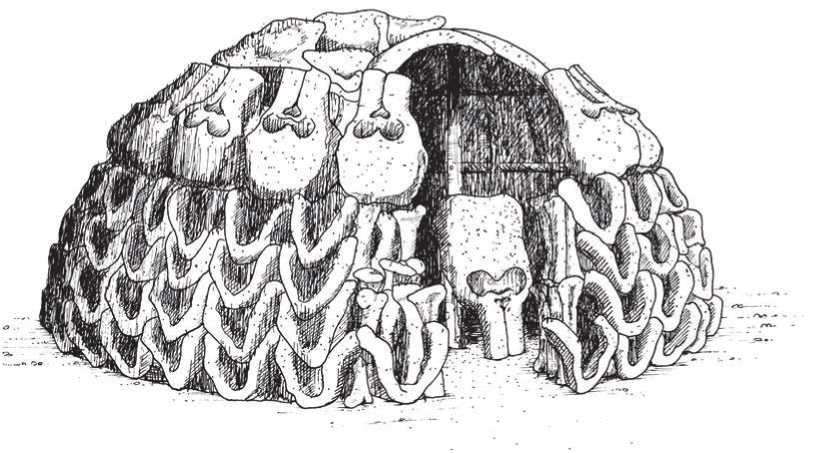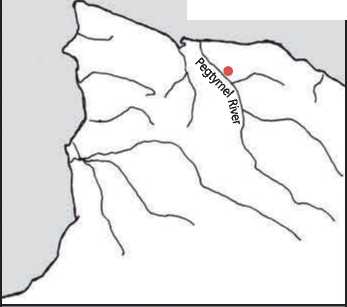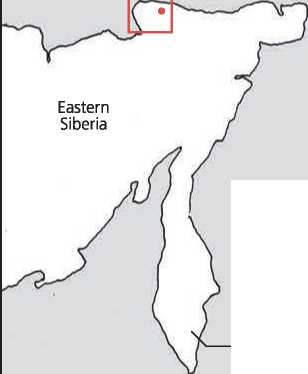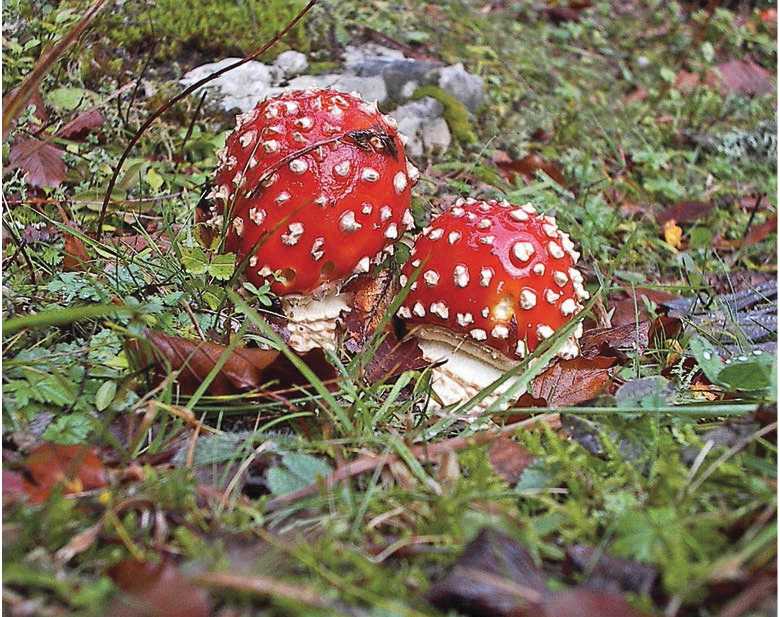In Russia, evidence of the great hunting tradition comes in the form of scrapers and blades found from Uzbekistan in the west to Siberia in the east. Most of the sites are near waterways and probably close to animal migration crossings. A site in Russia, known as Mal’ta, is located on a terrace overlooking the left bank of the Belaya River, 100 kilometers northwest of Irkutsk and Lake Baika. Most of the houses were circular about 3.5 to 4 meters in diameter, and were probably built of poles covered with skins, using reindeer antlers for support, and with a central fireplace. These are probably summer homes. There were also more or less rectangular houses of with average dimensions of about 3 by 4 meters and were semi-subterranean, in that they were excavated a half a meter into the earth with the roof formed by poles and skins, and strengthened by antlers. These houses had a central fireplace formed by three stone slabs. One of these houses measured 14 by 6 meters, had several fireplaces, and was probably a winter long-house. Among the artifacts recovered were several Venus figurines as well as figures of birds, some carved from the ivory of a mammoth. At Studenoe-2 (ca. 15,000 bce) located along the Chikoi River, archaeologists also found the remains of a 7 by 4.5 meter Gravettian communal-style oval hut that was probably built of wood and brush and covered with skins reinforced at its base with stones. The floor was paved with a layer of red ochre. At least four rock-lined hearths are aligned with the long axis of the dwelling.15 These houses served as the prototype of an architectural tradition that would last for thousands of years and span the Asian and American continents.
With an abundance of mammoth bones available, people soon figured out how to build impressive, durable shelters made completely out of mammoth bones; these can be found at Molodova and Mezhirich, Ukraine, dating to about 13,000 bce (Figure 2.13). One Molodova hut had 15 internal hearths, though they were probably not all used at the same time. The entrance, significantly enough, was to the east. Bones were used to weigh down the hides from

Figure 2.13: Mammoth bone house, Mezhirich, Ukraine. Source: Mark Jarzombek
East Siberian S

East Siberian Sea

Bering S
Kamchat
Peninsu
A

Figure 2.14a, b: (a) map; (b) Chukotka petroglyphs at Kaikuul' Cliff. Source: Mark Jarzombek/N. N. Pikov, Mysteries of the Rocks of Ancient Chukotka, translated by Richard L. Bland (Washington: U. S. Department of the Interior, 1999), 129, 142
The winds. Another hut, some 4 to 5 meters across, had walls built out of lower jaws laid in a careful herringbone pattern; another had a palisade-like ring of long bones placed on end. It has been estimated that the total number of bones incorporated into some of these structures might have required at least ninety-five animals. To preserve meat, the inhabitants dug pits into the permafrost to store their supply and thus were able to live os' their reserves even when the migratory herds had long since passed. The pits were also used to store bones over the summer. As there was little wood to be found in the open steppe, bones, which become flammable when dried in the arctic weather, were used for fuel.16 Whether the mammoth houses were used as base camps or were more permanent sites of habitation is not known. They may also have served as cult or ritual centers.
By the ninth millennium bce, the large animals in Inner Asia had become extinct, forcing the hunting cultures to focus on horses and reindeer. Even until the eighteenth century, the main prey of the Yukaghir in the upper Kolyma Valley in Siberia was wild reindeer. The hunt was undertaken twice a year when the migrating reindeer crossed the large rivers and were vulnerable to hunters on boats or waiting on the shores. The Chukotka, who came to inhabit the remote northeastern peninsula of Russia, specialize to this day on reindeer hunting and herding, even though they also developed sometime later whale hunting skills and began to build semi-subterranean houses out of whale bones. Along the Pegtymel River in northern Siberia, in the heart of Chukotka territory, there are spectacular clifi's that reach to about 30 meters in height with hundreds of drawings on them clearly made over difi'erent times thousands of years ago (Figure 2.14a and 2.14b). Some were ground in or rubbed on, others pecked out or scratched. Many depict deer and several show a boat with a man on it who has thrust a spear or harpoon into a swimming deer. The boats are of various types representing a fast kayak hermetically covered with skins, as are widely used by the Eskimos and Aeuts and Chukchi even into modern times. This place was thus more than just a convenient spot for deer hunting, which took place as the deer cross the river. It was a regional sacred site. The people gathered for ritualistic hunts and celebrations, using the clifi's as a type of tribal sanctuary.17 Some men are represented with what appears to be an umbrellashaped headdress. This could have been shaman or the spirits of a dance ritual. The image also looks a lot like the mushroom Amanita muscaria, which has a distinctive round head. The fact that it is red must also have played a role in its symbolic importance, not to mention the fact that the mushrooms have a hallucinogenic efi'ect (Figure 2.15). They are still being used by Siberian shamen.





 World History
World History









